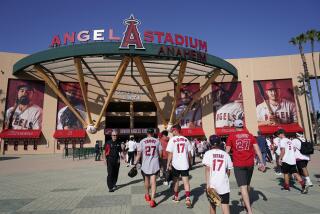Resist the NFL blitz
Stop me if you’ve heard this before.
There’s a plan to build a football stadium in Los Angeles that would coax an NFL team back to the city and boost the area’s economy. But if practice follows form, City Hall will never get beyond the emotional appeal of professional football and ask the bottom-line financial questions that would keep the proposal from draining money from essential city services.
There are actually two proposals.
One is from Majestic Realty Co., the folks who helped build Staples Center downtown. Its stadium is planned for the City of Industry, and Majestic purportedly wouldn’t ask Los Angeles to sell bonds or provide a subsidy of any kind.
The proposal I’m concerned with here is from Anschutz Entertainment Group, Majestic’s partner in the Staples Center project. AEG would rather build its own $1.5-billion stadium next to its arena and the L.A. Live complex and the city’s Convention Center.
I worked for Los Angeles City Councilman Joel Wachs from 1971 to 2001, and in the 1990s I become well versed in the public financing issues surrounding the Staples Center project. Since I retired, one of my personal passions has been to continue looking out for L.A. taxpayers, so I’ve immersed myself in the scores of analyses by independent economists — usually university professors — that drill to the financial core of stadium projects across the country. Almost without exception those studies show two things.
The first is that stadium proponents will overstate the project’s economic benefits and understate its costs to the public. To protect their reputations, analysts hired by the developers will include a disclaimer that they never verified the data given to them by the developers.
And football fans, reporters and city officials will be the first ones jumping on the bandwagon, juiced up by the excitement of having a new team regardless of the costs.
Not even AEG’s Philip Anschutz has been convinced yet that it’s a project worth backing with his own money. Yet AEG wants the City Council to commit the public’s funds first.
To clear a spot for the stadium, a huge chunk of the Convention Center — the West Hall — would have to be demolished and rebuilt on what little remaining adjacent space the city owns.
Setting aside the traffic and environmental issues that will never get addressed unless AEG is required to prepare a proper environmental impact report, it’s the financial details of the possible multibillion-dollar project that demand everyone’s immediate attention.
Los Angeles taxpayers should be concerned that AEG has not explained where the money would come from to rebuild the Convention Center’s lost West Hall space so the facility could maintain at least its second-tier status nationally. AEG has estimated the replacement cost at $350 million. However, if the plan eventually calls for the cash-strapped city to sell 30-year bonds to pay for it, the total cost would ultimately push north of $1 billion.
Also left out of the discussion is that taxpayers are still coughing up $48 million each year to pay off more than $500 million in bonds that were used many years ago to expand the Convention Center.
Despite AEG’s assurances to the contrary, it’s hard to believe that Convention Center bookings wouldn’t be affected during construction of the replacement for the West Hall space, thereby reducing the revenue needed to make payments on the existing bonds.
Those who believe that taxpayers should subsidize more economic growth in this part of downtown should ask whether a new football stadium and its handful of events is the best option. Maybe just expanding the Convention Center would be a better asset for downtown and the rest of the city.
AEG is giving the city until March to commit to a deal, and it’s a sure bet that the details won’t be released until the last minute.
The state is $25 billion or more in the hole. The city is looking to fill a $350-million gap in its upcoming budget while emergency services are being reduced.
So now is a perfect time for concerned taxpayers to write to the mayor and their City Council members and urge them to do the following: Get advice from experts who don’t have a financial interest in the project, and begin asking the tough financial questions. And use the same due diligence in investing the taxpayers’ money that they would use if it were their own money.
Greg Nelson, chief of staff to former Los Angeles City Councilman Joel Wachs, is a contributor to CityWatchLA.com.
More to Read
Go beyond the scoreboard
Get the latest on L.A.'s teams in the daily Sports Report newsletter.
You may occasionally receive promotional content from the Los Angeles Times.










